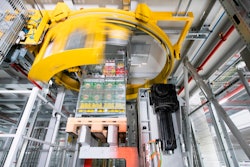
Over the years, the warehouse automation market has shifted from discrete islands of automation like standalone automated storage and retrieval systems (AS/RS) and put-to-light systems toward complex networks of automation all working in unison. Furthermore, the types of logistical operations warehouses are performing are getting more complex as retailers look to adopt e-commerce and omni-channel distribution strategies.
Automation vendors are responding by offering more sophisticated software solutions, such as warehouse execution systems (WES) and warehouse management systems (WMS). However, many vendors report their software business units are a cost center rather than a profit center. In effect, the software group is often seen as a function to support the hardware. The most successful warehouse automation vendors see software as a profit center and the hardware is used to complement the software.
Warehouse automation hardware is quickly getting commoditized and margins are eroding over time. To maintain high margins, software is becoming increasingly important, but in order for warehouse automation software to command higher margins it must demonstrate tangible value.
Here are 5 effective strategies that automation vendors can adopt in order to significantly increase the profitability of their software solutions.
1. Building execution capabilities to supercharge warehouse operations
Imagine a Google Maps for your warehouse – that’s the essence of a WES. Unlike traditional warehouse control systems (WCS) that follow pre-defined routes, the WES employs dynamic variables to orchestrate order processing, optimizing warehouse throughput by intelligently releasing orders based on real-time constraints . For instance, if a downstream put-wall is congested, the WES slows down order releases to avoid idle time for upstream pickers.
Automation vendors are ideally positioned to create execution capabilities. However, competition is heating up from WMS vendors that leverage real-time data from WCS solutions to optimize warehouses.
2. Embrace low-cost WCS solutions
As eWES from WMS vendors and intelligent sub-system control software from automation OEMs take on more decision-making roles, the perceived value of WCS is diminishing. With higher intelligence in automation solutions, WCS is tasked with fewer crucial decisions, in effect dumbing down the system.
To tackle this challenge head-on, automation vendors should adopt a dual approach. Firstly, enhance existing WCS solutions to create robust warehouse control execution systems (cWES) with execution capabilities.
Secondly, focus on offering affordable, easily integrated and configurable WCS solutions that seamlessly complement upstream WES and downstream sub-system control systems.
3. Standalone software solutions
Providing standalone software solutions comes with multiple advantages.
Firstly, engaging customers early in the process allows automation vendors to gain valuable insights, meaning they have a better understanding of clients’ needs before implementing automation solutions. Building trust and nurturing relationships become top priorities.
Secondly, offering stand-alone software establishes automation vendors as software experts, elevating their status within the industry beyond being seen as hardware-centric. This shift in perception opens doors to generate higher margins.
4. Introduce a license fee
While many warehouse automation vendors express interest in introducing license fees for their software, most continue to operate on a pure CapEx perpetual license model. Recurring software revenues can be unlocked through cloud-based services, but deploying WCS in the cloud presents latency challenges. Nonetheless, some automation vendors are now launching execution software in the cloud while retaining the control layer on-premise. This approach allows for the deployment of foundational WCS on-premise while offering higher value execution layers through a SaaS model.
5. Migrate to a micro-services architecture
Many legacy system integrators are burdened with monolithic software solutions resulting from past mergers and acquisitions. These inflexible systems struggle to adapt to new market forces. In contrast, a micro-services architecture, with its independent modules communicating seamlessly, offers numerous benefits. For instance, it allows for easy updates and separate development streams for different micro-services. In the warehouse automation sector, this architecture enables the creation of micro-services for various robotic providers, ensuring easy updates when interfaces change. Moreover, individual micro-services can be created for each automation system, facilitating focused workstreams on specific solutions.
The use of a micro-services architecture is the key to maintaining a high-performing software stack that can be easily updated and adapted to the current market forces.
Software solutions provide the key to future profitability
As the warehouse automation market continues to evolve, software solutions are the key to unlocking profitability for automation vendors. By embracing strategies such as building execution capabilities, offering low-cost WCS solutions, providing stand-alone software, introducing license fees, and migrating to a micro-services architecture, automation vendors can position themselves for success in an ever-changing market. As technology advances, the power of software will play an increasingly crucial role in shaping the future of warehouse automation.




















